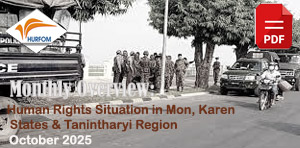Unprecedented use of forced porters by Burmese army in Tenasserim Division
January 6, 2010
HURFOM, Tenasserim: According to reports from local sources, 440 villagers from villages throughout Tenasserim Division were recently forced to carry supplies for soldiers under command of the Military Operation Management Comment (MOMC) No.20. MOMC No.20 is based in Tenasseerim Division, under the command of Brigadier General Thein Kyaw Myint.
A retired Karen National Union (KNU) officer, who had been informed by village headmen from the beset villages, told HURFOM’s field reporter that most villagers forced to porter were Karen. The porters were forced to carry loads such as rice and cooking materials for soldiers. According to retired officer, this is the first time in his experience so many villagers have been forced into portering in one operation. The porters carry goods consisted of both men and women.
The 440 villagers who were used for portering were drawn from the following villages: Naw Tae, 40 people; Thin Baw Oo, 50 people; Tha Ra Wa Chaung, 70 people; Zinma Gang, 30 people; Tee Chaung Wa, 70 people; Par Kying, 30 people; Kyauk Lone, 40 people; King Nee Gang, 40 people; Tha Mu, 30 people; Moe Row, 40 people.
HURFOM is able to confirm that this is the first time a Burmese army State Peace and Development Council (SPDC) battalion has used this large a number of villagers to porter goods in Tenasserim Division. Prior reports of portering have remained relatively small ranging from only few people to maximally 2 dozen.
According to residents, porters were requested from each household through the village headmen. Each family had to send one person to work, regardless of number of family members or conditions at home. In previous instances, when villagers in the area learned of the Burmese army approach, they would flee, leaving a much smaller number of people for the military to press into portering.
According one of the victims of portering, the gathered porters had to carry loads from Moe Row to Now Tae, Kyauk Par, Par Lar or Chaund Pa Ya, all of which are located along the Thai Burma.
The march took porters on average 7 days to complete, having to walk approximately 32 miles to and from their destination. Every villager had to carry around 30 kilograms walking by foot through jungle and mountain terrain. In addition, according to those who served as porters, they were neither paid nor provided any food.
“We started our journey in the 29th of December, some have returned [home] but some have not,” commented Saw Thin, 30 year-old who had been forced to porter and has recently returned home. “Villagers not only did not get paid but they had to bring their own food. During our journey we were [treated] like animals. We had to sleep on the ground with no blankets.”
According to Saw Thin, there were around 15 women involved in the portering. He explained that several of these women admitted to being under the age under the age 18 and were from Tee Chaung and King Nee Gang. Saw Thin, who had contact with the women when they were assembled to pick up their packs to porter in Moe Row, said that since no one has known what happened on them, and they have yet to return home.
All villages are based under control of KNU, thus qualifying the area in the SPDC’s terminology as a still contested “Black Area”. Military units from the SPDC often commit a variety of human rights abuses without consequence, including forced portering, forced road repairs and construction, forced cleaning of brush at army camps, arbitrary taxation, and even extrajudicial execution. It is not currently clear why such a large number of porters was requisitioned into carrying goods.
Comments
Got something to say?
You must be logged in to post a comment.



















































